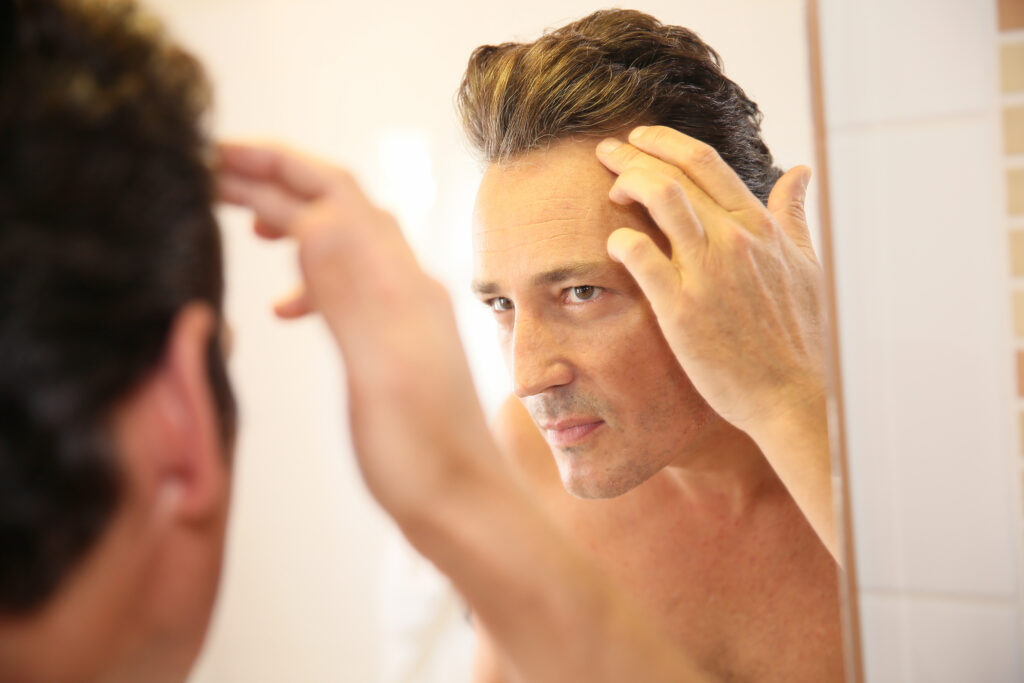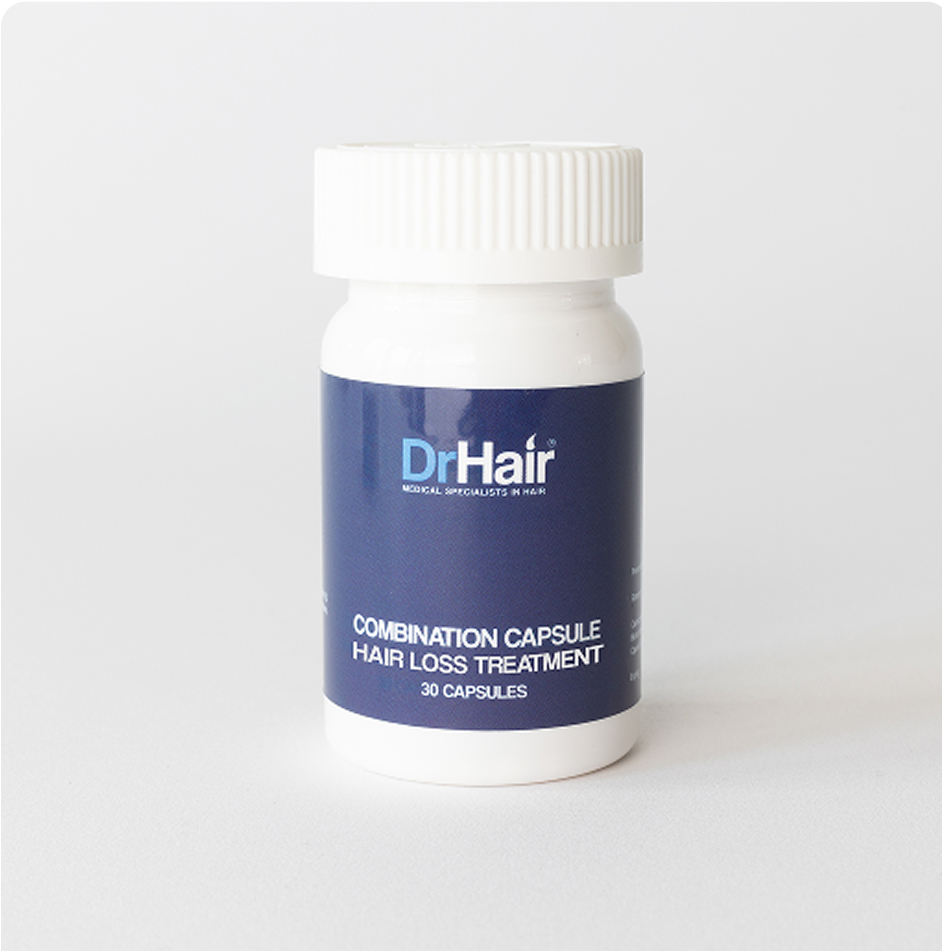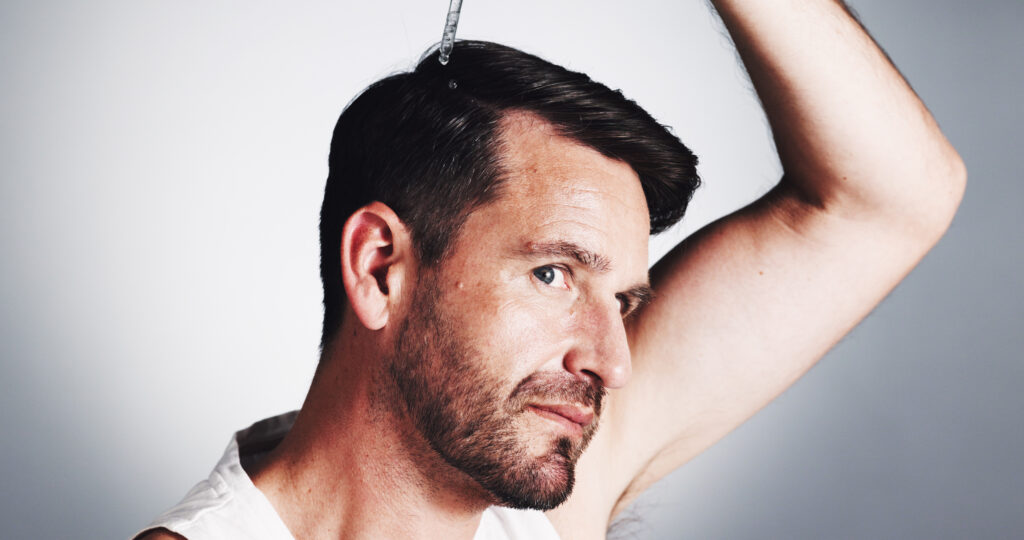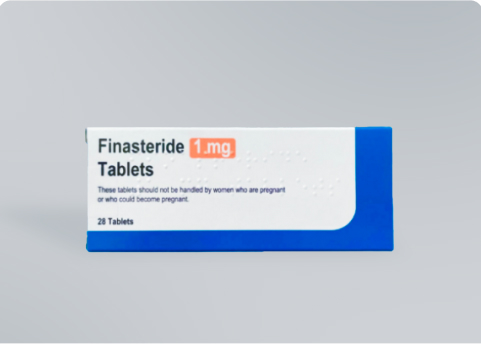You may have heard of finasteride – a beacon of hope for many men struggling with male pattern baldness. It’s been a key player in the battle against hair loss since 1997 (1), when up to 53% of men over 40 had to cope with or cover up this condition (2).
But, what does the evidence say about finasteride? Does it reduce further hair loss? And does it help with hair regrowth?
Here, we discuss what finasteride is and how effective it is at reducing hair loss.
Table of Contents
What is finasteride?
Finasteride, a 5-alpha reductase inhibitor, is a unique drug that limits the activity of an enzyme, 5-alpha reductase. This mechanism halts the conversion of testosterone into dihydrotestosterone (DHT), a male sex hormone. The reduction of DHT in the body, a hormone that in excess can cause hair loss, is the key to finasteride’s effectiveness.
While during early development DHT provides a pivotal role in the establishment of male sex organs and other distinguishingly male characteristics (such as a deep voice), as you get older, too much DHT can be more of a hindrance than a help (9).
In excess, DHT can cause two unwanted effects – one being an enlarged prostate, and the other being hair loss (9). So, when finasteride inhibits the conversion of testosterone to DHT, you are left with less circulating DHT, potentially pausing the clock on further hair loss.
How is finasteride used?
Finasteride is usually prescribed as an oral drug which is taken daily at a dosage of 1mg (for hair loss purposes). However, topical finasteride products are also available. These are applied directly to the scalp and may be favoured by some men, especially if they’ve experienced systemic effects such as reduced libido or erection issues when taking oral finasteride (3). Learn more about whether topical finasteride works for hair loss.
How effective is finasteride?
One of the key factors in finasteride’s effectiveness is the duration of treatment. In other words, the longer you take it, the more significant the effects will likely be. – Results show that just 5 years (4) of treatment are more effective at stopping hair loss than 1 year of use, and 10 years (5) of finasteride use produces even more substantial impacts.
Finasteride efficacy is apparent in both oral and topical treatments (6). While one study noted a slight increase in efficacy for oral vs topical, both produced meaningful reductions in hair loss (7). Topical finasteride offers a localised treatment that may reduce systemic or serious side effects of finasteride experienced by some during oral therapies (8).
Considering its comparable efficacy, topical finasteride formulas (often combined with minoxidil for improved outcomes) are another successful hair loss treatment option.

Does finasteride work better for mild hair loss?
Evidence suggests finasteride is more successful if you’re earlier in the hair loss process – most studies are focused on men with mild to moderate hair loss, rather than severe/complete loss(10). This could be particularly true if hair regrowth is the measure of success, as discussed below.
However, there is hope wherever you are in your hair loss process. DrHair can provide you with personalised treatment options to suit your circumstances. Sometimes, staying on hair loss treatment for an extended period may be beneficial, or you might be best off using other treatment options for a more satisfactory outcome. So, don’t lose hope – there is a lot of help at hand.
Can finasteride increase hair regrowth?
Finasteride has the potential to stimulate significant hair regrowth. Evidence suggests that after two years of treatment, you could achieve over 15% regrowth rates per inch of skin(11). This indicates the relatively short time required for favourable outcomes, giving hope to those seeking to regrow their hair.
However, it’s worth noting that this study was conducted on men without severe hair loss, so it is unlikely to be as successful in these instances. But even then, you are likely to halt further hair loss at least, even if your regrowth rate isn’t as impressive.
Another exciting study showed that over 90% of men using finasteride experienced some hair regrowth while undergoing treatment (5). So while you aren’t guaranteed to regrow a full head of hair – and it helps to be realistic about outcome potential – evidence indicates that most men experience at least some hair growth on finasteride.
Can finasteride make hair loss worse?
This is an important question to address, as the last thing you want is to worsen the very thing you are trying to treat. But, fear not – there’s some reassuring evidence on this front that should instill confidence in your treatment choice.
For example, a study comparing hair loss for men taking oral finasteride to a placebo found that over 80% of men on the finasteride did not experience additional hair loss during their treatment period (12).
Meanwhile, nearly 80 percent of men on the non-active placebo had continued hair loss during the same period.
An even more reassuring study showed that as many as 99 percent of men on finasteride had no further hair loss during the treatment(5). This is a very positive finding and highlights both the efficacy and low risk where further hair loss is concerned.
It’s important to note, however, that you can sometimes experience a temporary increase in hair shedding after starting finasteride. This is entirely normal and nothing to worry about. Once your hair adapts to the new growth cycle, this shedding will stop.
Does finasteride work on men and women?
Generally, finasteride is not prescribed routinely for female pattern hair loss(13). Even though it is usually only prescribed very occasionally and off-label for females, evidence has shown that it might be suitable for women suffering from raised androgen levels (14).
Women have a different hormonal profile than men, so other treatments suit female hair loss better. Minoxidil for women often works effectively with tolerable or minimal side effects. Similarly, there’s good evidence to support the use of topical finasteride for women.
Finasteride is an effective and safe treatment choice
In conclusion, finasteride is an effective and satisfying treatment option for the majority of men, and this is true whether oral or topical finasteride is used. Multiple studies have proven that finasteride treatment can reduce future hair loss while potentially increasing hair regrowth. While men with mild-to-moderate hair loss may experience better outcomes than those with severe hair loss, most men will notice a reduction in future hair loss.
If you would like to experience the benefits of finasteride treatment, but would prefer a personalised service that can tailor therapy to your situation and needs, DrHair can help. Book an online consultation with our experienced doctor-led support team, and they will help you determine if this medication is the best choice for you or if you could benefit more from another one of our hair loss products.
FAQs
Learn more about finasteride and its effectiveness in these frequently asked questions.
Yes – the evidence is clear that finasteride will reduce further hair loss in most men. Studies have shown that over 90% of men experience reduced hair loss during finasteride treatment, pausing the clock for further hair recession.
For some men, there was an increase in hair growth of over 15% per inch of skin. The likelihood of increased hair growth appears linked to the severity of hair loss, with more significant outcomes in those with milder hair loss at treatment.
Both topical and oral finasteride have been proven effective at reducing hair loss. One study showed that oral finasteride was slightly more effective than topical treatment, but more evidence is needed to confirm this.
Finasteride works best in individuals with mild to moderate hair loss, unlike in those with more severe hair loss. However, with a longer treatment time, finasteride may reduce further hair loss, even in more severe cases. Speak to your doctor to see if finasteride is your best option.











